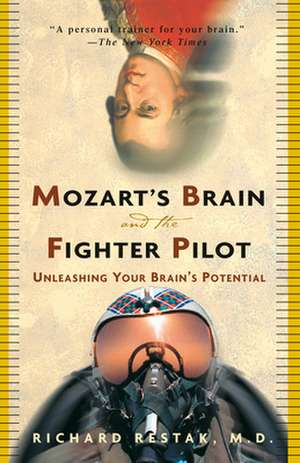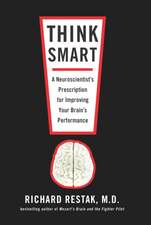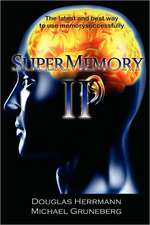Mozart's Brain and the Fighter Pilot
Autor Richard Restaken Limba Engleză Paperback – 24 apr 2003
Everything we think and everything we choose to do alters our brain and fundamentally changes who we are, a process that continues until the end of our lives. Few people think of the brain as being susceptible to change in its actual structure, but in fact we can preselect the kind of brain we will have by continually exposing ourselves to rich and varied life experiences. Unlike other organs that eventually wear out with repeated and sustained use, the brain actually improves the more we challenge it.
Most of us incorporate some kind of physical exercise into our daily lives. We do this to improve our bodies and health and generally make us feel better. Why not do the same for the brain? The more we exercise it, the better it performs and the better we feel. Think of Restak as a personal trainer for your brain he will help you assess your mental strengths and weaknesses, and his entertaining book will set you to thinking about the world and the people around you in a new light, providing you with improved and varied skills and capabilities. From interacting with colleagues to recognizing your own psychological makeup, from understanding the way you see something to why you re looking at it in the first place, from explaining the cause of panic attacks to warding off performance anxiety, this book will tell you the whys and hows of the brain s workings.
Packed with practical advice and fascinating examples drawn from history, literature, and science, Mozart s Brain and the Fighter Pilot provides twenty-eight informative and realistic steps that we can all take to improve our brainpower."
Preț: 93.65 lei
Nou
Puncte Express: 140
Preț estimativ în valută:
17.92€ • 18.47$ • 15.13£
17.92€ • 18.47$ • 15.13£
Carte disponibilă
Livrare economică 11-25 februarie
Preluare comenzi: 021 569.72.76
Specificații
ISBN-13: 9780609810057
ISBN-10: 0609810057
Pagini: 224
Ilustrații: 44 line drawings
Dimensiuni: 132 x 204 x 12 mm
Greutate: 0.17 kg
Ediția:Pbk.
Editura: HARMONY
ISBN-10: 0609810057
Pagini: 224
Ilustrații: 44 line drawings
Dimensiuni: 132 x 204 x 12 mm
Greutate: 0.17 kg
Ediția:Pbk.
Editura: HARMONY
Notă biografică
Richard Restak, M.D., is a neurologist, neuropsychiatrist, and clinical professor of neurology at George Washington University Medical Center. He is the author of the bestselling book The Brain, a companion to the PBS series of the same name, as well as The Mind and The Brain Has a Mind of Its Own. He lives in Washington, D.C.
Extras
Chapter 1
Learn as much as possible about how your brain works.
This is the most important factor in getting smart and staying smart. In order to do this, you don't have to become a neurologist or subscribe to scholarly journals on neuroscience (the study of the brain at every operating level ranging from everyday observable behavior to brain processes taking place at the level of chemicals and molecules). Here is a useful summary of the facts you should know.
The adult human brain weighs about three pounds and consists of about 100 billion nerve cells or neurons along with an even greater number of non-neuronal cells called glia (in Greek, glia means "glue") interspersed among the neurons. The neurons are responsible for the communication of information throughout the brain. Especially important is the brain's outer wrinkled mantle, the cerebral cortex, which gives the brain the appearance of a gnarled walnut. The cerebral cortex contains about 30 billion neurons linked to one another by means of a million billion neuronal connections called synapses.
As pointed out by Nobel Prize-winning neuroscientist Gerald Edelman, more than 32 million years would be required to count all of the synapses in the human brain at a counting rate of one synapse per second. And if we concentrate on the number of possible neuronal connections (circuits) within the brain, we get an even more astounding number: 10 followed by a million zeros. To put that number into some kind of perspective, consider that the number of particles in the known universe comes to only 10 followed by seventy-nine zeros. Finally, consider that the glia, which exceed the number of neurons by at least a power of 10, are also believed to be capable of communication. If this is true, then the number of possible brain states exceeds even our most extravagant projections.
Any of the brain's 100 or so billion neurons can potentially communicate with any other via one or more linkages. Indeed, each neuron is no more than two or three degrees of separation from another. Linkages, once formed, are strengthened by repetition. At the behavioral level, this takes the form of habit. Each time you practice a piano piece or a golf swing (presuming you are doing it correctly), your performance improves. This corresponds at the neuronal level to the establishment and facilitation of neuronal circuits.
The cerebral cortex consists of the outer gray matter of the cerebral hemispheres and the cerebellum, the two structures that contain most of the neurons in the brain. Less than a quarter inch in thickness, this thin rind (cortex in the original Latin means "rind"), includes some 85 percent of all brain tissue. An obvious feature of the cerebral cortex is its highly convoluted surface and wrinkled appearance. This wrinkling serves the purpose of increasing the surface area of this thin outer layer without a corresponding increase in volume and size (similar to wrinkling a handkerchief so that the larger surface area can be contained in the smaller confines of a wallet or small purse).
While it's true that certain brain areas are specialized (such as the centers for processing sight, sound, touch, and other qualities and properties), the largest portion of the brain, the association cortex, is devoted to establishing networks and thereby linking everything together throughout the brain. As a result of this networking, you don't separately see, hear, taste, smell, and feel your breakfast bagel-you experience it as a unity. It's the association cortex that makes that possible. Figure B, on page 23, shows the association cortex. Notice that it makes up more than 90 percent of the brain. Figure A, on page 22, depicts the other major brain areas along with some of their specialized functions. Notice that the right and left hemispheres are specialized for different functions as depicted in Figure C, on page 24, and discussed in detail later in the book.
Below the cerebral hemispheres lies a group of nuclei (collections of nerve cells) that organize movement. These nuclei, called the basal ganglia, enable you to do such things as skillfully maneuver your way through heavy traffic while simultaneously rehearsing what you're going to say at the business meeting later in the morning. In computer terms, the cerebral cortex writes the software programs for actions and, after some practice on your part, the basal ganglia take over to run the programs that enable you to carry out the actions. When you learn the tango, for instance, you have to concentrate (i.e., use the cerebral cortex) to plan, learn, and get comfortable with the steps. But after some practice and experience, you're eventually able to tango while thinking of other things because the basal ganglia are operating that system automatically.
Toward the back of the brain resides the cerebellum, a center involved in movement, balance, and coordination. The last time you watched a gymnast at the top of his or her form you were watching the cerebellum operating at its highest level. But the structure is not just for balance and coordination; it is also involved in the planning activities that precede movement.
Nevertheless, as we will illustrate throughout this book, the brain can't be considered only in terms of its separate components. Think of it as a unified structure in which each part contributes toward its total functioning. As an example, suppose you suddenly decide you'd like a pizza. That thought is formulated as an action plan by the frontal lobes, which are located just behind your forehead, and results in impulses directed to the cerebellum. Your cerebellum, along with structures from the basal ganglia (sometimes referred to as subcortical motor centers), translates the frontal lobes' action plan into a motor program. First you make a phone call and arrange for the pizza delivery; then you pay the delivery person upon arrival; finally, you sit down, open the box, and reach in for that first slice. Each of these separate motions involves different muscles activated in a different sequence. Or you might use different muscles depending on the circumstances. For instance, if your right elbow is slightly sore from too much tennis, you'll have to eat the pizza with your nondominant left hand. In order to make this switch, your cerebellum formulates a change in the motor program received from the frontal lobes. Indeed, the cerebellum springs into action prior to any perceptible movement on your part. Thus, when your hand approaches the pizza the cerebellum has already predicted and anticipated all of the necessary fine hand and finger movements that will take place over the next minute or so. Such an anticipatory function operates over your entire life span, during which your cerebellum regularly programs hundreds of thousands of action sequences involving every muscle in the body.
But your cerebellum isn't just a glorified personal trainer that integrates muscles into motor programs. The cerebellum is also integral to activities not involving movement at all, such as when you try to solve a problem, or remember someone's name, or maybe just do nothing more than sit and think. The cerebellum of music conductors, for instance, springs into action when the conductors listen to or read the score of an unfamiliar Bach chorale. Since the conductors are not moving at the time, their cerebellar activity must relate to their listening to and thinking about the music. As a practical application of this research finding that simply listening to or reading a musical score is sufficient for cerebellar activation, consider boosting your own brain circuitry by refining your musical appreciation and knowledge. As Gordon Shaw, a physicist at the University of California at Irvine, puts it, "music is tapping into an inherent structure of the brain." We'll say more about that "tapping" in chapter 23.
But the findings of cerebellar enhancement are not limited to music. Neuroscientists have known for years that any skilled activity enhances the cerebellum. In addition, we now know that imaging or mentally concentrating on the activities can accomplish a similar result. Of course, that doesn't mean you can become a musician or an athlete by thought alone. You have to undertake the discipline of learning how to play the violin or perfecting your tennis backhand. But once you've made progress in your training, imaging can help activate and sustain the necessary circuits. Extensive two-way connections between cerebellum and frontal cortex make this possible.
Indeed, thought and movement are integrated via the two-directional interplay between the cerebrum-the enlarged wrinkled structure at the top of the brain-and the cerebellum. Mental agility and physical agility complement rather than act in opposition to each other. Therefore, relegate to the Museum of Outmoded Ideas your stereotypes of "dumb" athletes and physically inactive superpower intellects. In most instances, your typical professional athlete spends many hours mentally rehearsing the moves or plays that bring victory. And most writers and other intellectuals try to put aside some time each day for exercise: they've learned that even a short exercise break clears the head and gets the intellectual juices flowing again.
And what about the emotional response to such experiences? That's when the limbic system kicks into gear. The limbic system is a shorthand term for the brain structures within and below the cerebrum. Its most important components are the cingulate gyrus in the cerebrum and the hippocampus and amygdala buried below the cerebral hemispheres.
On the microscopic level, neurons interconnect with one another for the purpose of processing electrical and chemical information. One of the great mysteries of the human brain concerns how these electrical and chemical codes are converted into your desire for that pizza. So far, no one has the solution to the mystery-which is usually referred to as the mind-brain problem. Perhaps nobody will ever solve it, since comparing electrical and chemical events to everyday human decisions is like comparing apples to oranges. When you ordered the pizza, all kinds of interesting activities were going on within your brain-the biological structure one neuroscientist once compared to "an enchanted loom." But how to relate those electrical and chemical changes that take place when you crave a pizza? Nobody has a clue.
Many highly branched processes referred to as dendrites (from the Greek word for "tree") convey incoming information from one neuron to another. (Arborization is the term used to convey the treelike appearance and structure of those neurons and their connections. When nerve tissue is looked at through a microscope, the overlapping of the processes of the many neurons looks like the branches of trees.) Each neuron receives information from as many as one thousand other neurons by way of contact on one of its dendrites. The mechanism for transporting outgoing information to another cell involves the axon, a single process that extends outward for varying lengths until reaching its end point, the nerve terminal. By convention, two communicating neurons are referred to as presynaptic (the message carrier) and postsynaptic (the message receiver), with any two communicating cells separated from each other by a tiny space, the synapse.
At the synapse, communication changes from an electrical impulse to a chemical one. Neurotransmitters (chemical messengers) are released from the messenger cell and diffuse across the synapse to lock onto a specialized receptor. Advances over the past three decades in our knowledge about the brain's microscopic and chemical organization have made possible successful treatments for psychiatric illnesses like depression and anxiety. The drugs work by altering the balance of neurotransmitters within the synapse. But the same alteration can be brought about by changes in attitude and behavior. We will say more about this in later chapters.
From the Hardcover edition.
Learn as much as possible about how your brain works.
This is the most important factor in getting smart and staying smart. In order to do this, you don't have to become a neurologist or subscribe to scholarly journals on neuroscience (the study of the brain at every operating level ranging from everyday observable behavior to brain processes taking place at the level of chemicals and molecules). Here is a useful summary of the facts you should know.
The adult human brain weighs about three pounds and consists of about 100 billion nerve cells or neurons along with an even greater number of non-neuronal cells called glia (in Greek, glia means "glue") interspersed among the neurons. The neurons are responsible for the communication of information throughout the brain. Especially important is the brain's outer wrinkled mantle, the cerebral cortex, which gives the brain the appearance of a gnarled walnut. The cerebral cortex contains about 30 billion neurons linked to one another by means of a million billion neuronal connections called synapses.
As pointed out by Nobel Prize-winning neuroscientist Gerald Edelman, more than 32 million years would be required to count all of the synapses in the human brain at a counting rate of one synapse per second. And if we concentrate on the number of possible neuronal connections (circuits) within the brain, we get an even more astounding number: 10 followed by a million zeros. To put that number into some kind of perspective, consider that the number of particles in the known universe comes to only 10 followed by seventy-nine zeros. Finally, consider that the glia, which exceed the number of neurons by at least a power of 10, are also believed to be capable of communication. If this is true, then the number of possible brain states exceeds even our most extravagant projections.
Any of the brain's 100 or so billion neurons can potentially communicate with any other via one or more linkages. Indeed, each neuron is no more than two or three degrees of separation from another. Linkages, once formed, are strengthened by repetition. At the behavioral level, this takes the form of habit. Each time you practice a piano piece or a golf swing (presuming you are doing it correctly), your performance improves. This corresponds at the neuronal level to the establishment and facilitation of neuronal circuits.
The cerebral cortex consists of the outer gray matter of the cerebral hemispheres and the cerebellum, the two structures that contain most of the neurons in the brain. Less than a quarter inch in thickness, this thin rind (cortex in the original Latin means "rind"), includes some 85 percent of all brain tissue. An obvious feature of the cerebral cortex is its highly convoluted surface and wrinkled appearance. This wrinkling serves the purpose of increasing the surface area of this thin outer layer without a corresponding increase in volume and size (similar to wrinkling a handkerchief so that the larger surface area can be contained in the smaller confines of a wallet or small purse).
While it's true that certain brain areas are specialized (such as the centers for processing sight, sound, touch, and other qualities and properties), the largest portion of the brain, the association cortex, is devoted to establishing networks and thereby linking everything together throughout the brain. As a result of this networking, you don't separately see, hear, taste, smell, and feel your breakfast bagel-you experience it as a unity. It's the association cortex that makes that possible. Figure B, on page 23, shows the association cortex. Notice that it makes up more than 90 percent of the brain. Figure A, on page 22, depicts the other major brain areas along with some of their specialized functions. Notice that the right and left hemispheres are specialized for different functions as depicted in Figure C, on page 24, and discussed in detail later in the book.
Below the cerebral hemispheres lies a group of nuclei (collections of nerve cells) that organize movement. These nuclei, called the basal ganglia, enable you to do such things as skillfully maneuver your way through heavy traffic while simultaneously rehearsing what you're going to say at the business meeting later in the morning. In computer terms, the cerebral cortex writes the software programs for actions and, after some practice on your part, the basal ganglia take over to run the programs that enable you to carry out the actions. When you learn the tango, for instance, you have to concentrate (i.e., use the cerebral cortex) to plan, learn, and get comfortable with the steps. But after some practice and experience, you're eventually able to tango while thinking of other things because the basal ganglia are operating that system automatically.
Toward the back of the brain resides the cerebellum, a center involved in movement, balance, and coordination. The last time you watched a gymnast at the top of his or her form you were watching the cerebellum operating at its highest level. But the structure is not just for balance and coordination; it is also involved in the planning activities that precede movement.
Nevertheless, as we will illustrate throughout this book, the brain can't be considered only in terms of its separate components. Think of it as a unified structure in which each part contributes toward its total functioning. As an example, suppose you suddenly decide you'd like a pizza. That thought is formulated as an action plan by the frontal lobes, which are located just behind your forehead, and results in impulses directed to the cerebellum. Your cerebellum, along with structures from the basal ganglia (sometimes referred to as subcortical motor centers), translates the frontal lobes' action plan into a motor program. First you make a phone call and arrange for the pizza delivery; then you pay the delivery person upon arrival; finally, you sit down, open the box, and reach in for that first slice. Each of these separate motions involves different muscles activated in a different sequence. Or you might use different muscles depending on the circumstances. For instance, if your right elbow is slightly sore from too much tennis, you'll have to eat the pizza with your nondominant left hand. In order to make this switch, your cerebellum formulates a change in the motor program received from the frontal lobes. Indeed, the cerebellum springs into action prior to any perceptible movement on your part. Thus, when your hand approaches the pizza the cerebellum has already predicted and anticipated all of the necessary fine hand and finger movements that will take place over the next minute or so. Such an anticipatory function operates over your entire life span, during which your cerebellum regularly programs hundreds of thousands of action sequences involving every muscle in the body.
But your cerebellum isn't just a glorified personal trainer that integrates muscles into motor programs. The cerebellum is also integral to activities not involving movement at all, such as when you try to solve a problem, or remember someone's name, or maybe just do nothing more than sit and think. The cerebellum of music conductors, for instance, springs into action when the conductors listen to or read the score of an unfamiliar Bach chorale. Since the conductors are not moving at the time, their cerebellar activity must relate to their listening to and thinking about the music. As a practical application of this research finding that simply listening to or reading a musical score is sufficient for cerebellar activation, consider boosting your own brain circuitry by refining your musical appreciation and knowledge. As Gordon Shaw, a physicist at the University of California at Irvine, puts it, "music is tapping into an inherent structure of the brain." We'll say more about that "tapping" in chapter 23.
But the findings of cerebellar enhancement are not limited to music. Neuroscientists have known for years that any skilled activity enhances the cerebellum. In addition, we now know that imaging or mentally concentrating on the activities can accomplish a similar result. Of course, that doesn't mean you can become a musician or an athlete by thought alone. You have to undertake the discipline of learning how to play the violin or perfecting your tennis backhand. But once you've made progress in your training, imaging can help activate and sustain the necessary circuits. Extensive two-way connections between cerebellum and frontal cortex make this possible.
Indeed, thought and movement are integrated via the two-directional interplay between the cerebrum-the enlarged wrinkled structure at the top of the brain-and the cerebellum. Mental agility and physical agility complement rather than act in opposition to each other. Therefore, relegate to the Museum of Outmoded Ideas your stereotypes of "dumb" athletes and physically inactive superpower intellects. In most instances, your typical professional athlete spends many hours mentally rehearsing the moves or plays that bring victory. And most writers and other intellectuals try to put aside some time each day for exercise: they've learned that even a short exercise break clears the head and gets the intellectual juices flowing again.
And what about the emotional response to such experiences? That's when the limbic system kicks into gear. The limbic system is a shorthand term for the brain structures within and below the cerebrum. Its most important components are the cingulate gyrus in the cerebrum and the hippocampus and amygdala buried below the cerebral hemispheres.
On the microscopic level, neurons interconnect with one another for the purpose of processing electrical and chemical information. One of the great mysteries of the human brain concerns how these electrical and chemical codes are converted into your desire for that pizza. So far, no one has the solution to the mystery-which is usually referred to as the mind-brain problem. Perhaps nobody will ever solve it, since comparing electrical and chemical events to everyday human decisions is like comparing apples to oranges. When you ordered the pizza, all kinds of interesting activities were going on within your brain-the biological structure one neuroscientist once compared to "an enchanted loom." But how to relate those electrical and chemical changes that take place when you crave a pizza? Nobody has a clue.
Many highly branched processes referred to as dendrites (from the Greek word for "tree") convey incoming information from one neuron to another. (Arborization is the term used to convey the treelike appearance and structure of those neurons and their connections. When nerve tissue is looked at through a microscope, the overlapping of the processes of the many neurons looks like the branches of trees.) Each neuron receives information from as many as one thousand other neurons by way of contact on one of its dendrites. The mechanism for transporting outgoing information to another cell involves the axon, a single process that extends outward for varying lengths until reaching its end point, the nerve terminal. By convention, two communicating neurons are referred to as presynaptic (the message carrier) and postsynaptic (the message receiver), with any two communicating cells separated from each other by a tiny space, the synapse.
At the synapse, communication changes from an electrical impulse to a chemical one. Neurotransmitters (chemical messengers) are released from the messenger cell and diffuse across the synapse to lock onto a specialized receptor. Advances over the past three decades in our knowledge about the brain's microscopic and chemical organization have made possible successful treatments for psychiatric illnesses like depression and anxiety. The drugs work by altering the balance of neurotransmitters within the synapse. But the same alteration can be brought about by changes in attitude and behavior. We will say more about this in later chapters.
From the Hardcover edition.
Descriere
Using the latest research in neurology and psychology, Restak, an eminent neuropsychologist and bestselling author of "The Brain Has a Mind of Its Own, " explains how the brain works and tells how to make it work better. Included are 28 easy, practical exercises designed to improve cognitive abilities. 44 illustrations.

















